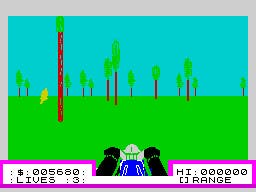3D Deathchase
Quick, before death gets away!
First, we should try and remember just how long ago 1983 was, otherwise nothing about Deathchase will seem remarkable. It would be unjust to rob this brightly coloured 16K hero of its rightful title as a genuine, carnage-centric classic that provided the much needed deforestation of rampant, trite, cutesy games so today's wonderful concrete sprawl of shameless hyper-violent entertainment barrages could be built.
It looks crap now, and plays like a lame pig, but in the insipid '80s Deathchase was a marvel to behold. Gamers had never seen such a high-octane, reckless dance with the devil on their home computers and the excited confusion of magazine reviews spoke volumes about the state of gaming at the time. Reviewers sat at their mechanical typewriters astounded and lost for words after their breathtaking, breakneck pursuit through Micromega's lush forests, with no comparisons to draw for the guilty exhilaration they experienced when mercilessly gunning down tanks, helicopters and other bikers without any real cause other than brazen entertainment. Fourteen levels of rapid, sadistic mayhem through both night and day shocked (and delighted) the gaming world as never before.

Deathchase broke the racing barrier as the power bike waved goodbye to the stereotypical racetrack with two fingers, this is true, but Mervyn Escourt's influential racer did so much more. Although no one knew it at the time, it was a grand overture to today's prolific first person shooter genre, and only escaped controversy and criticism during its life on the shelves as conscientious objectors hadn't yet turned their tunnel vision on home computers.
It came and went as quickly as the bike muscled through the relentless forest, but Deathchase introduced the world to the concept of aggressive, mature gaming, and we should feel obliged to fire off a round of bullets into the sky in homage to a true genre founding title.
